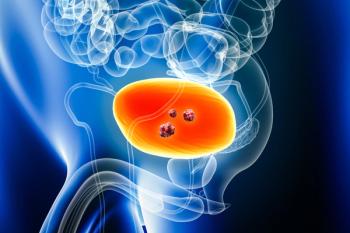
Using Polygenic Risk Score to Better Outcomes in Primary Open-Angle Glaucoma
Current studies are using a polygenic risk score to evaluate the risk and clinical outcomes in primary open-angle glaucoma (POAG).
This content originally appeared on our sister site,
Genetic investigations have pinpointed specific genes involved in early-onset familial disease with autosomal dominant or recessive inheritance as well as genetic risk factors for common
The major goal of genetic research is to put that genetic information to work clinically to identify at-risk individuals and use the knowledge about disease-causing genes to develop novel therapies, according to Janey Wiggs, MD, PhD, the Paul Austin Chandler Professor of Ophthalmology, Harvard Medical School, Massachusetts Eye and Ear, in Boston.
Current studies have set out to evaluate the risk and clinical outcomes in primary open-angle glaucoma (POAG) based on development of a polygenic risk score (PRS) applied to data in genome-wide association studies (GWASs).
READ MORE:
POAG genetics and risks
Multiple gene variants are needed to lead to greater disease risk and greater impact on disease outcomes; the contribution of a single genetic variant is small.
To assess the genetic risk for POAG, Wiggs said, multiple variants must be tested simultaneously using a genetic risk score, such as the recently developed PRS, to measure the genome-wide genetic risk for an individual.
This score determines the total number of genetic risk variants for each person, and individuals in a population are scored based on the number of DNA risk variants they have.
The individuals with the highest number of variants have the highest genetic burden that is likely to have the greatest impact on disease risk and outcome.
In analyses, the outcomes of individuals with the highest PRS (highest percentile) are often compared with the overall population distribution or with individuals with the lowest genetic burden.
To develop this valuable tool, 2 requirements must be met: a GWAS that is large enough to facilitate identifying all potential variants to be included in the PRS and use of computational methods that can manage large data sets and create the score, Wiggs said.
International Glaucoma Genetics Consortium
The consortium, which included investigators worldwide, was formed to complete the GWASs to identify all genetic risk variants for POAG. Each research group contributed its clinical and genetic data from POAG cases and controls.
A transancestry meta-analysis1 was performed using all data sets that resulted in identification of 127 different chromosomal regions significantly associated with the risk for POAG.
Each region contains hundreds to thousands of genetic variants individually associated with disease risk, Wiggs reported.
All the information from the participating groups worldwide was used to create a POAG PRS, which was applied to different populations and data sets to evaluate the clinical outcomes, she said.
Results
When the investigators evaluated the impact of the PRS on disease risk, they found that individuals in the upper decile (the top 10% of the PRS) had a 15 times greater risk of developing disease compared with individuals in the lower decile.
“This supported the concept that the PRS is associated with greatly increased risk,” Wiggs pointed out.
The results also showed that individuals with the highest genetic burden as defined by the PRS had a 5- to 10-year earlier disease onset compared with individuals in the bottom PRS distribution.
The PRS was also found to be associated with increased IOP. A recent Australian study2 showed individuals with the highest PRS had higher IOP throughout the day, which was especially true in the morning, and these individuals with the highest PRS had increased IOP spikes.
“These results suggested that home tonometry would be useful in patients with high PRS to accurately assess the IOP burden,” Wiggs said.
The highest PRS is also associated with aging, thinner retinal nerve fiber layers, and the proportion of patients requiring trabeculectomy to control IOP.3
Shifting to myocilin-related glaucoma, a recent study4 reported that the MYOC mutations can cause juvenile AOG and early POAG, and the most common mutation was found to be MYOC p.Gln368Ter in UK Biobank carriers.
Two hundred carriers were identified in this study who had IOP measurements and fundus photographs. The goal was to determine the disease rate (penetrance), diagnosis rate, and effect of the POAG PRS among mutation carriers.
Wiggs reported the PRS influenced both the disease penetrance and disease severity, which supported the use of PRS in optimizing risk stratification among MYOC p.Gln368Ter mutation carriers.
“People who were mutation carriers were much more likely to have evidence of disease as defined by elevated IOP and disc-defined glaucoma if they were also in the high PRS percentiles,” she said.
Moreover, among patients with glaucoma who were mutation carriers, those in the highest percentiles were far more likely to have received a diagnosis, suggesting that having the myocilin mutation and a high PRS causes more severe disease that is evident to the patient.
A study of increased caffeine consumption5 and the PRS interaction on IOP and the risk of POAG found that caffeine only caused IOP elevations in patients with the highest PRS.
The individuals with higher IOP resulting from higher caffeine intake also had a higher risk of glaucoma.
The main takeaways from this line of research are that a large GWAS made the development of a PRS for POAG possible.
A high genetic burden defined by the POAG PRS is associated with early disease onset by 10 to 15 years, higher IOP, thinner nerve fiber layer, and a greater need for surgery.
The PRS can modify disease outcomes due to other genes, such as MYOC; and the PRS can interact with environmental factors to influence the disease risk, Wiggs said.
--
Janey Wiggs, MD, PhD
E: [email protected]
This article was adapted from Wiggs’ presentation at the Women in Ophthalmology 2021 Summer Symposium. She has no financial interest in this subject matter.
---
REFERENCES
1. Gharahkhani P, Jorgenson E, Hysi P, et al. Genome-wide meta-analysis identifies 127 open-angle glaucoma loci with consistent effect across ancestries. Nat Commun. 2021;12(1):1258. doi:10.1038/s41467-020-20851-4
2. Qassim A, Mullany S, Awadalla MS, et al. A polygenic risk score predicts intraocular pressure readings outside office hours and early morning spikes as measured by home tonometry. Ophthalmol Glaucoma. 2021;4(4):411-420. doi:10.1016/j.ogla.2020.12.002
3. Craig JE, Han X, Qassim A, et al. Multitrait analysis of glaucoma identifies new risk loci and enables polygenic prediction of disease susceptibility and progression. Nat Genet. 2020;52(2):160-166. doi:10.1038/s41588-019-0556-y
4. Zebardast N, Sekimitsu S, Wang J, et al. Characteristics of p.Gln368Ter myocilin variant and influence of polygenic risk on glaucoma penetrance in the UK Biobank. Ophthalmology. 2021;128(9):1300-1311.
5. Kim J, Aschard H, Kang JH, et al. Intraocular pressure, glaucoma, and dietary caffeine consumption: a gene–diet interaction study from the UK Biobank. Ophthalmology. 2021;128(6):866-876. doi:10.1016/j.ophtha.2020.12.009
Newsletter
Stay at the forefront of cutting-edge science with CGT—your direct line to expert insights, breakthrough data, and real-time coverage of the latest advancements in cell and gene therapy.












































